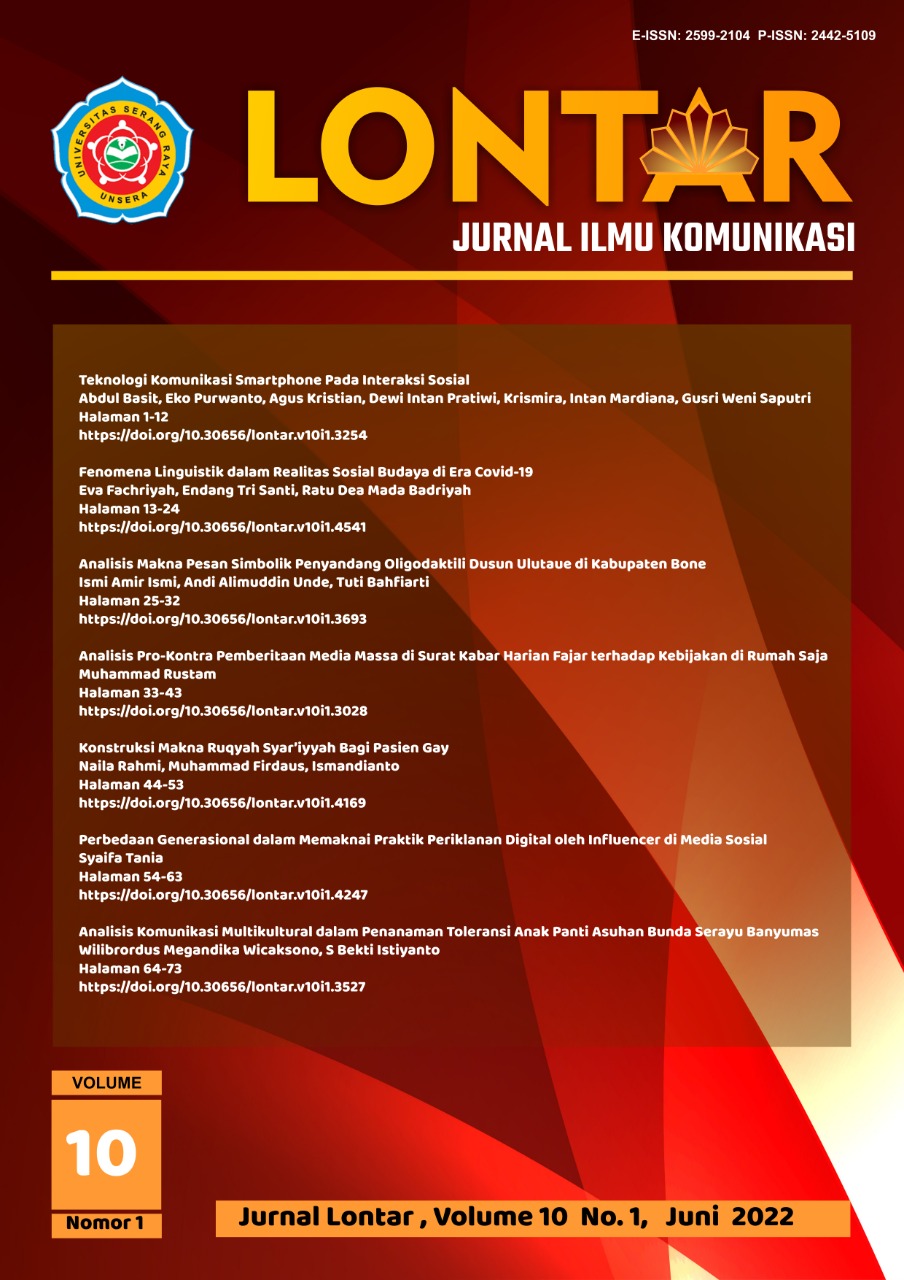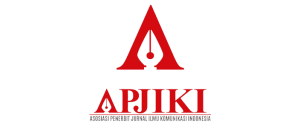Teknologi Komunikasi Smartphone Pada Interaksi Sosial
DOI:
https://doi.org/10.30656/lontar.v10i1.3254Keywords:
Smartphone, Communication Technology, Social interactionAbstract
The use of smartphones causes several changes in the behavior of a person who tends to be complacent with his world without caring about society. Smartphones can have a positive or negative impact depending on their use. This study aims to determine whether there is an influence of smartphone communication technology on social interaction. The research method used quantitative methods, the population was carried out at PT Paragon Technology and Innovation with a sample of 150. The results showed that there was an influence in it, that smartphone communication technology has links with users related to the process of social interaction, this can be proven by how someone uses communication tools in everyday life. The social interaction built by employees within the company seems to be very good, this is evidenced by the hypothesis obtained from data processing that smartphone communication technology in every interaction with colleagues has no effect. The interaction process will run well if it is done with face-to-face communication, without any interference from the communication tool, namely smartphones.
References
Abdul Basit & Adie Dwiyanto Nurlukman. (2021). Branding Kota Pinta Pada Teknologi Komunikasi Tangerang Live. Dinamisia : Jurnal Pengabdian Kepada Masyarakat, 5(6), 1429–1439. https://doi.org/10.31849/dinamisia.v5i6.5275
Aljomaa, S. S., Al.Qudah, M. F., Albursan, I. S., Bakhiet, S. F., & Abduljabbar, A. S. (2016). Smartphone addiction among university students in the light of some variables. Computers in Human Behavior, 61, 155–164. https://doi.org/10.1016/j.chb.2016.03.041
Asnifatima, A., & Listyandini, R. (2020). Produktivitas Kerja Karyawan Pt Citra Abadi Sejati Tahun 2019 Pendahuluan. 3(4).
Aziz, M., & Nurainiah, N. (2018). Pengaruh Penggunaan Handphone Terhadap Interaksi Sosial Remaja Di Desa Dayah Meunara Kecamatan Kutamakmur Kabupaten Aceh Utara. Jurnal AL-IJTIMAIYYAH: Media Kajian Pengembangan Masyarakat Islam, 4(2), 19–39. https://doi.org/10.22373/al-ijtimaiyyah.v4i1.4204
Billieux, J. (2012). Problematic Use of the Mobile Phone: A Literature Review and a Pathways Model. Current Psychiatry Reviews, 8(4), 299–307. https://doi.org/10.2174/ 157340012803520522
Camacho, E., LoPresti, M., Appelboom, G., Dumont, E., Taylor, B., & Connolly, E. S. (2014). The ubiquitous role of smartphones in mobile health. Biom Biostat Int J, 1(1), 00004.
Chen, C., Krieger, M. L., & Sundar, S. S. (2021). Smartphones, robots, and social media: Aging with communication technologies. In Handbook of the Psychology of Aging (pp. 139–153). Elsevier. https://doi.org/10.1016/B978-0-12-816094-7.00014-3
Cho, H.-Y., Kim, D. J., & Park, J. W. (2017). Stress and adult smartphone addiction: Mediation by self-control, neuroticism, and extraversion. Stress and Health, 33(5), 624–630.
Chóliz, M. (2010). Mobile phone addiction: A point of issue. Addiction, 105(2), 373–374.
Choliz, M. (2012). Mobile-phone addiction in adolescence: The test of mobile phone dependence (TMD). Progress in Health Sciences, 2(1), 33–44.
Collier, R. (2016). Mental health in the smartphone era. Canadian Medical Association Journal, 188(16), 1141–1142. https://doi.org/10.1503/cmaj.109-5336
Dwyer, R. J., Kushlev, K., & Dunn, E. W. (2018). Smartphone use undermines enjoyment of face-to-face social interactions. Journal of Experimental Social Psychology, 78, 233–239. https://doi.org/10.1016/j.jesp.2017.10.007
Foehr, U. G. (2006). Media multitasking among American youth: Prevalence, predictors and pairings. Henry J. Kaiser Family Foundation.
Gao, Y., Li, A., Zhu, T., Liu, X., & Liu, X. (2016). How smartphone usage correlates with social anxiety and loneliness. PeerJ, 4, e2197. https://doi.org/10.7717/peerj.2197
Haris, A., & Amalia, A. (2018). Makna Dan Simbol Dalam Proses Interaksi Sosial (Sebuah Tinjauan Komunikasi). Jurnal Dakwah Risalah, 29(1), 16. https://doi.org/10.24014/jdr.v29i1.5777
Harwood, J., Dooley, J., Scott, A. J., & Joiner, R. (2014). Constantly connected–The effects of smart-devices on mental health. Computers in Human Behavior, 34, 267–272. https://doi.org/10.1016/j.chb.2014.02.006
Haug, S., Castro, R. P., Kwon, M., Filler, A., Kowatsch, T., & Schaub, M. P. (2015). Smartphone use and smartphone addiction among young people in Switzerland. Journal of Behavioral Addictions, 4(4), 299–307. https://doi.org/10.1556/2006.4.2015.037
Intan Trivena Maria Daeng, Mewengkang, N. N., & Kalesaran, E. R. (2017a). 91161-ID-penggunaan-smartphone-dalam-menunjang-ak. E-Journal “Acta Diurna,†1(1), 1–15.
Intan Trivena Maria Daeng, Mewengkang, N. N., & Kalesaran, E. R. (2017b). Penggunaan Smartphone Dalam Menunjang Aktivitas Perkuliahan Oleh Mahasiswa Fispol Unsrat Manado Oleh. E-Journal “Acta Diurna,†6(1), 1–15.
Kim, J.-H. (2017). Smartphone-mediated communication vs. face-to-face interaction: Two routes to social support and problematic use of smartphone. Computers in Human Behavior, 67, 282–291. https://doi.org/10.1016/j.chb.2016.11.004
Kushlev, K., Dwyer, R., & Dunn, E. W. (2019). The social price of constant connectivity: Smartphones impose subtle costs on well-being. Current Directions in Psychological Science, 28(4), 347–352.
Lee, H., Kim, J. W., & Choi, T. Y. (2017). Risk Factors for Smartphone Addiction in Korean Adolescents: Smartphone Use Patterns. Journal of Korean Medical Science, 32(10), 1674. https://doi.org/10.3346/jkms.2017.32.10.1674
Lee, H., & Park, N. (2014). Nature of Youth Smartphone Addiction in Korea [SNU Journal]. https://s-space.snu.ac.kr/handle/10371/92844
Leung, L. (2008). LINKING PSYCHOLOGICAL ATTRIBUTES TO ADDICTION AND IMPROPER USE OF THE MOBILE PHONE AMONG ADOLESCENTS IN HONG KONG. Journal of Children and Media, 2(2), 93–113. https://doi.org/10.1080/17482790802078565
Lin, Y.-H., Chang, L.-R., Lee, Y.-H., Tseng, H.-W., Kuo, T. B., & Chen, S.-H. (2014). Development and validation of the Smartphone Addiction Inventory (SPAI). PloS One, 9(6), e98312.
Ling, R., Pedersen, P. E., Diaper, D., & Sanger, C. (2005). Mobile Communications: Re-negotiation of the Social Sphere (Vol. 31). Springer London. https://doi.org/10.1007/1-84628-248-9
Marsal, A., & Hidayati, F. (2017). Pengaruh Smartphone Terhadap Pola Interaksi Sosial Pada Anak Balita Di Lingkungan Keluarga Pegawai Uin Sultan Syarif Kasim Riau. Jurnal Ilmiah Rekayasa Dan Manajemen Sistem Informasi, 3(1), 78–84.
Matic, A., Osmani, V., & Mayora-Ibarra, O. (2012). Analysis of Social Interactions Through Mobile Phones. Mobile Networks and Applications, 17(6), 808–819. https://doi.org/10.1007/ s11036-012-0400-4
Mawarpury, M., Maulina, S., Faradina, S., & Afriani. (2020). Kecenderungan Adiksi Smartphone Ditinjau dari Jenis Kelamin dan Usia. Psikoislamedia Jurnal Psikologi, 05, 24–37.
Mufid, M. (2012). Etika dan filsafat komunikasi. Prenada Media.
Mulyati, T., & Nrh, F. (2018). Kecanduan Smartphone Ditinjau Dari Kontrol Diri Dan Jenis Kelamin Pada Siswa Sma Mardisiswa Semarang. Empati, 7(4), 152–161.
Purbasari, V. A., & Suharno, S. (2019). Interaksi Sosial Etnis Cina-Jawa Kota Surakarta. Jurnal Antropologi: Isu-Isu Sosial Budaya, 21(1), 1. https://doi.org/10.25077/jantro.v21.n1.p1-9.2019
Rohida, L. (2018). Pengaruh era revolusi industri 4.0 terhadap kompetensi sumber daya manusia. Jurnal Manajemen Dan Bisnis Indonesia, 6(1), 114–136.
Sari, A. W. (2016). Pentingnya Ketrampilan Mendengar Dalam Menciptakan Komunikasi Yang Efektif. EduTech: Jurnal Ilmu Pendidikan Dan Ilmu Sosial, 2(1), Article 1. https://doi.org/10.30596/edutech.v2i1.572
Sbarra, D. A., Briskin, J. L., & Slatcher, R. B. (2019). Smartphones and close relationships: The case for an evolutionary mismatch. Perspectives on Psychological Science, 14(4), 596–618.
Taylor, H., Fieldman, G., & Altman, Y. (2008). E-mail at work: A cause for concern? The implications of the new communication technologies for health, wellbeing and productivity at work. Journal of Organisational Transformation & Social Change, 5(2), 159–173. https://doi.org/ 10.1386/jots.5.2.159_1
Verduyn, P., Schulte-Strathaus, J. C. C., Kross, E., & Hülsheger, U. R. (2021). When do smartphones displace face-to-face interactions and what to do about it? Computers in Human Behavior, 114, 106550. https://doi.org/10.1016/j.chb.2020.106550
White, J., Thompson, C., Turner, H., Dougherty, B., & Schmidt, D. C. (2011). Wreckwatch: Automatic traffic accident detection and notification with smartphones. Mobile Networks and Applications, 16(3), 285–303.
Widodo, A. S. (2019). Peran Internet dalam Meningkatkan Jumlah Pekerja Lepas di Indonesia. Nyimak: Journal of Communication, 3(2), 191. https://doi.org/10.31000/ nyimak.v3i2.1811
Worland, J. (2015). Why loneliness may be the next big public-health issue. Time Magazine.
Downloads
Published
Issue
Section
License
By submitting an article to the journal, the author(s) agree to transfer the published article's copyright to the journal, which will act as the publisher. This means the journal will have the right to publish the article in various forms, including reprints. The journal will maintain the publishing rights to the published articles.
In line with the license, authors and third parties (readers, researchers, and others) are allowed to share and adapt the material. In addition, the material must be given appropriate credit, provided with a link to the license, and indicated if changes were made. If authors remix, transform, or build upon the material, authors must distribute their contributions under the same license as the original.






